Overview
The 2015 Paris climate agreement saw world governments vouch to limit the rise in global temperatures. The ceiling was set at a maximum increase of 1.5 degrees Celsius above pre-industrial levels, and the primary route to achieving this goal was to cut greenhouse gas emissions.
Many greenhouse gases, like methane, carbon dioxide (CO2), and nitrous oxide, occur naturally. For centuries, the carbon cycle – the flux of CO2 between the atmosphere, biosphere, oceans, and crust of the Earth – was relatively balanced. This kept the surface temperature stable.
We are familiar with the fast carbon cycle – CO2 absorbed by a tree during the day or released with respiration. However, there is a slow part of the cycle that takes 100-200 million years, where carbon is moved to sediments, fossils, and rocks. Carbon can stay underground indefinitely, released primarily through volcano eruptions. But once we began extracting and burning these fossils in massive quantities, these large quantities of carbon were released back into the atmosphere. There is now so much being emitted that oceans and vegetation can no longer absorb all of it.
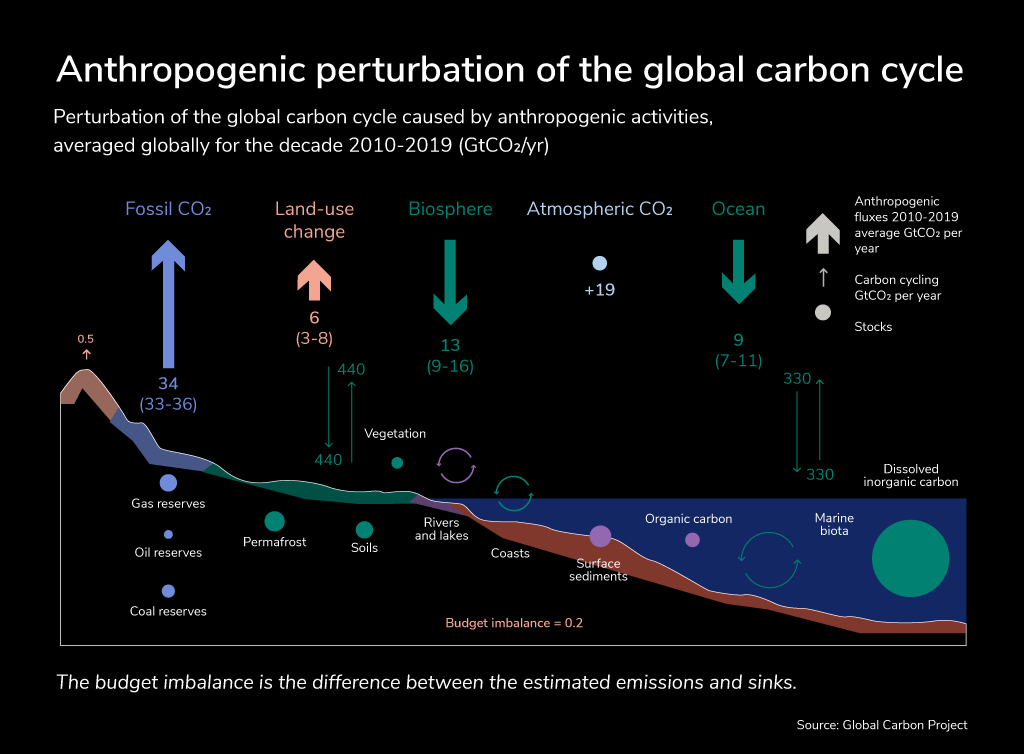
Another major greenhouse gas is methane, which is mainly emitted from livestock and landfills. It has 20 times the capacity of heating up the planet (global warming potential) than CO2, however, it has a much shorter lifespan. Its emissions can be cut by better agricultural practices (or by reducing red meat consumption altogether) and waste management (recycling, banning organic waste from landfills).
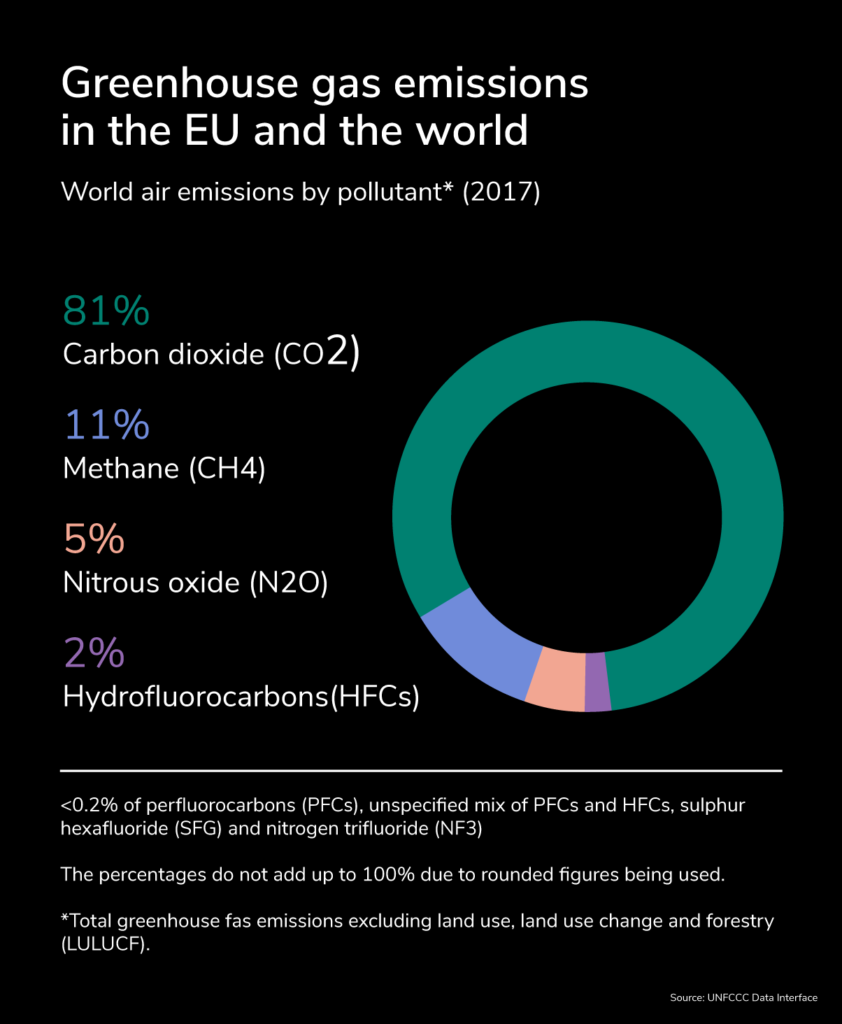
There is an almost linear relation between global warming and the number of emissions accumulating in our atmosphere. This resulted in the concept of a “carbon budget” – a number of cumulative emissions to not be overstepped. After this buffer is depleted, warming above the target is to be expected. Intergovernmental Panel on Climate Change (IPCC) estimates the remaining “carbon budget” of the planet to be 580 gigatons (Gt) of CO2 with a 50% chance of limiting warming to 1.5°C.
How much CO2 are we emitting?
In 2019, we emitted 43.04 Gt of CO2 globally (if land use is included in the calculation), which is a steady increase from 42.11 Gt in 2018.
We’ve never seen a concentration of CO2 this size in 800 000 years. A temporary drop in emissions in 2020 had very little effect on the atmospheric CO2 concentration.
The COVID-19 pandemic starting in 2020 brought emissions down by 6.4%, correlated with a 6.9% of global GDP contraction. We, therefore, expect that the economic recovery plans will not use the momentum of this emission drop.
Are we on track to stop climate change?
To limit the global rise of temperature to 1.5°C, emissions must drop rapidly, to reach 25 Gt by 2030. This is much lower than what we emit now (compared to 42.11 Gt in 2018, out of which 36.42 are from industry and fossil fuels).
Based on today’s commitments and economic trends, emissions are on track to reach 56 Gt in 2030, more than twice what they should be.
With the current pace of admissions, scientists predict that we will deplete the carbon budget for a 1.5°C scenario by 2028. This means that emission reduction is urgent and should be happening across all sectors. If every year of delay further depletes the budget, later climate action would need to be much more drastic rather than gradual.
Scenarios
IPCC and IEA are the two scenarios most frequently used to explain climate change and model the transition toward sustainability.
•IPCC (Intergovernmental Panel on Climate Change) is a body of the United Nations providing scientific information on climate change in periodically produced summaries. They do not carry out research but examine and summarize published literature on the topic, assessing the level of certainty of findings.
•IEA (International Energy Agency) was established in the framework of OECD. It provides information on specifically the global energy system, including its relation to climate change. It acts as a policy adviser to its member states, as well as major emerging economies. They regularly issue a report on energy transition, World Energy Outlook.
Intergovernmental Panel on Climate Change scenarios
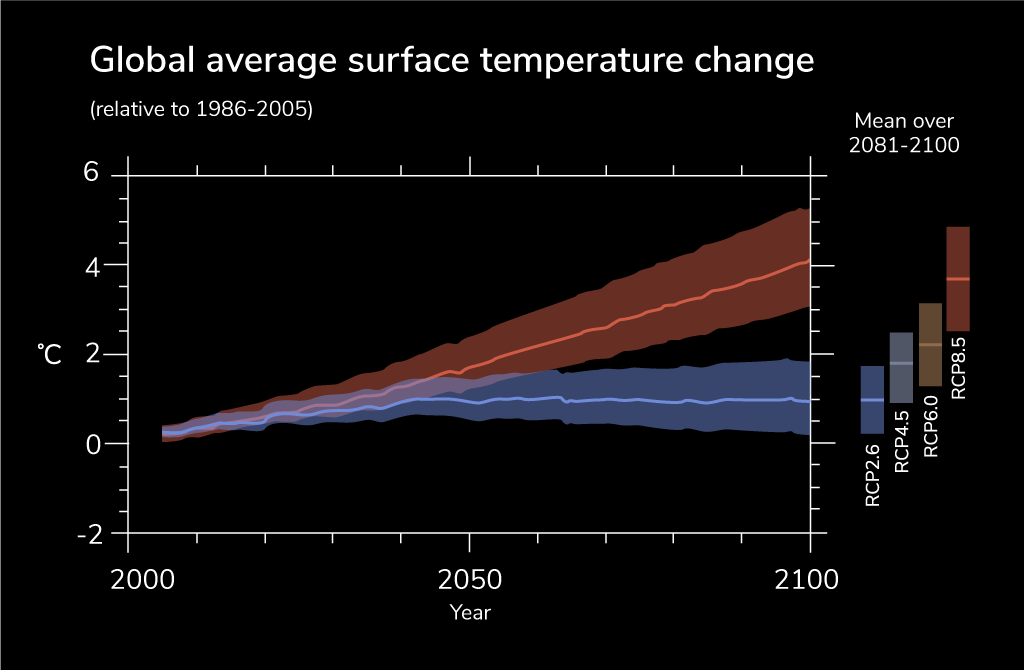
One of the most cited is IPCC’s Representative Concentration Pathways (RCPs). They describe different 21st-century climate change pathways, focusing on the number of emissions, atmospheric GHG concentrations (as the name would suggest), and corresponding climate impacts. They provide a general idea of how fast we are moving towards global warming and when to cut emissions. They are not policy recommendations, but models of climate outcomes. These four RCPs include one mitigation scenario (RCP2.6), two stabilization scenarios (RCP4.5 and RCP6), and one scenario with very high greenhouse gas emissions (RCP8.5).
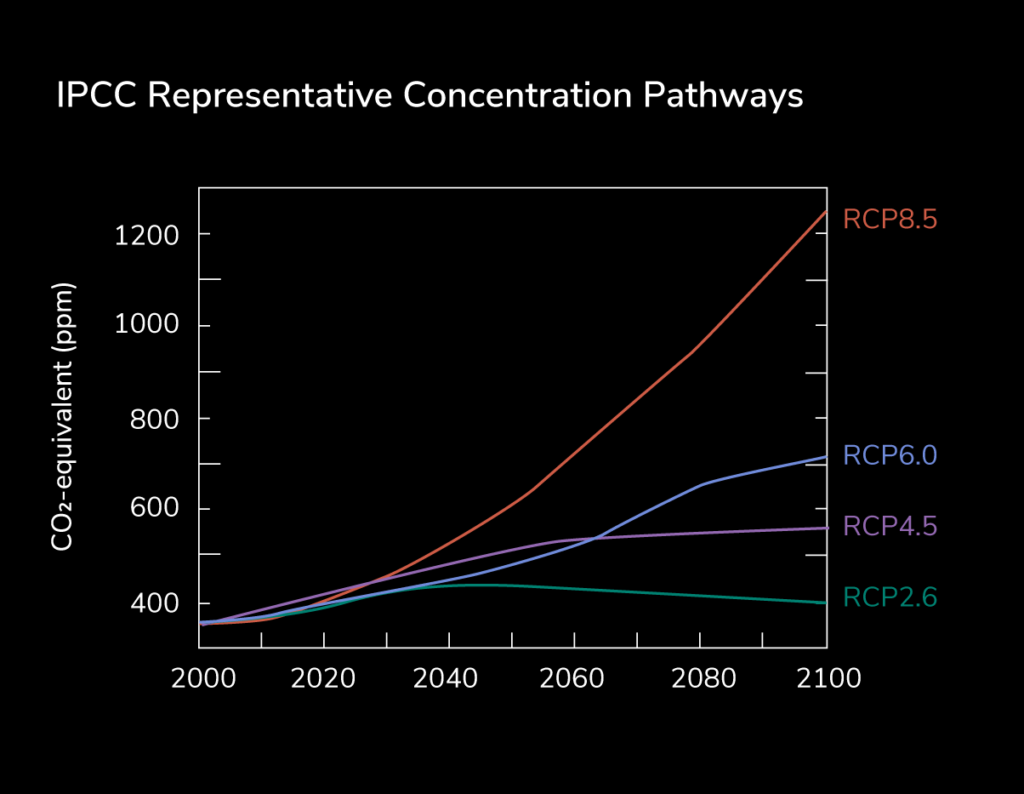
| RCP2.6 Warming of 0.3-1.7 degrees by 2100 | “A very stringent” pathway, requires that CO2 emissions start declining by 2020 and go to zero by 2100. It is the only one described as likely to keep global temperature rise below 2°C, meaning that delayed climate action will not be able to limit the warming full. Even under this scenario, sea level rise is expected. |
| RCP4.5 Warming of 1.1-2.6 degrees by 2100 | Intermediate scenario. Emissions peak around 2040, then decline. IPCC concludes that most small mammals will be unable to keep up at the rates projected under RCP4.5 and above. |
| RCP6.0 Warming of 1.4-3.1 degrees by 2100 | Another intermediate scenario. In RCP 6, emissions continue at a high rate, peak around 2080, then decline. Temperature rise above 2 is likely. |
| RCP8.5 Warming of 2.6-4-8 degrees by 2100 | Worst-case scenario. In RCP 8.5, emissions continue to rise throughout the 21st century. Temperatures are predicted to rise by 2.6-4.8 degrees. It involves an almost ice-free Arctic ocean in summer, a decrease in permafrost area of 81%, and many other climatic effects. |
More industry-specific scenarios are developed by IEA, focusing on energy-related sustainable development (clean energy, access to energy, etc.). They have the Sustainable Development Scenario (SDS) outlining an energy transition and the Stated Policies Scenario (STEPS) reflecting current commitments as a benchmark. Recently they also developed a pathway called NZE (Net Zero Emissions).
Stated Policies Scenario (STEPS)
IEA has assessed current commitments, intentions, and national policies related to climate and energy transition. In comparison with the previously mentioned RCP8.5, it’s not the worst-case scenario. It implies putting these existing policies into action. Still, IEA assesses that they are not enough to achieve sustainability. The momentum behind clean energy technologies is not enough to offset the effects of an expanding global economy and growing population. The rise in emissions slows, but with no peak approaching, the world falls far short of shared sustainability goals. To compare, they have formulated a Sustainable Development Scenario – to show the gap between current policies and actually needed action.
Sustainable Development Scenario (SDS)
SDS holds the temperature rise below 1.8 °C with a 66% probability. It is in line with Paris Agreement. To achieve the temperature goal, the Paris Agreement calls for emissions to peak as soon as possible and reduce rapidly, leading to a balance between anthropogenic emissions by sources and removals by sinks (i.e. net-zero). It also includes universal access to modern energy and reducing health impacts from energy-related air pollution. SDS states that global CO2 emissions from the energy sector and industrial processes should fall from 35.8 billion tonnes in 2019 to less than 10 billion tonnes by 2050 and be on track to net zero emissions by 2070. IEA states that humanity is not on the way to achieving this scenario.
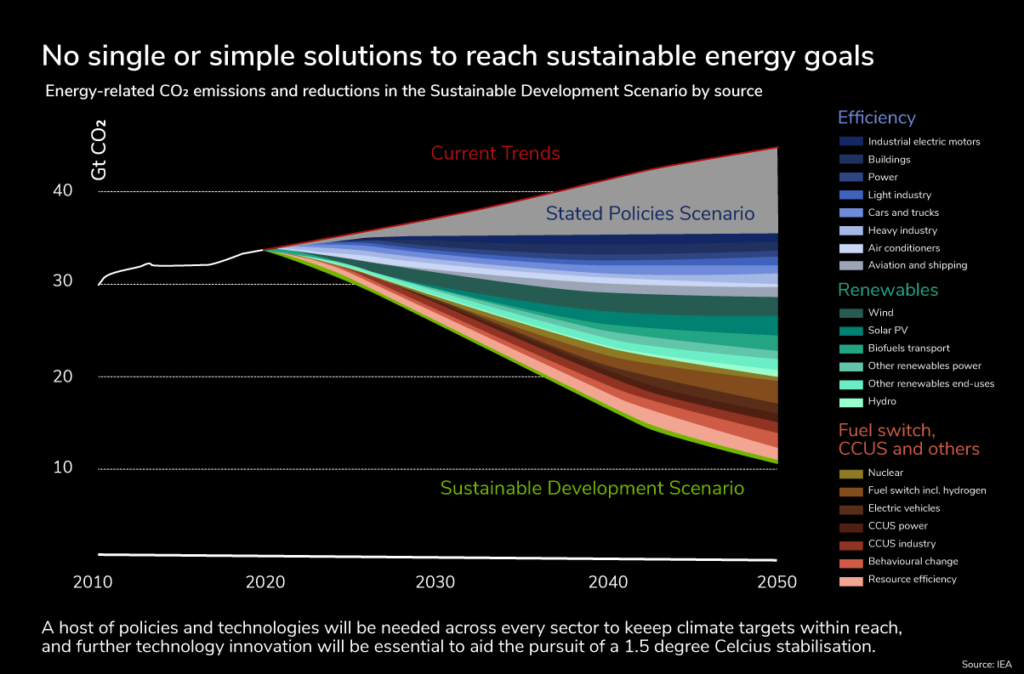
Net Zero Emissions by 2050 Scenario (NZE)
In 2021 IEA published a new report, titled, “Net Zero by 2050: A Roadmap for the Global Energy Sector”. There they elaborated more specifically on achieving clean energy goals, staying consistent with keeping the warming within 1.5 degrees range. The paper provides a roadmap with deadlines, taking concepts of SDS even further and emphasizing the departure from fossil fuels even more.
According to this pathway, global energy and industry-related emissions will fall by 40% between 2020-2030 and reach zero in 2050, both in immediate action and future innovations.
Solar and wind will become leading energy sources (70% in 2050), and fossil fuels are rapidly declining. Coal demand will fall by 90% in 2050, oil – by 75%, and natural gas – by 55%. Using low-emissions electricity instead of fossil fuels drives approximately one-fifth of emission reduction by 2050. In transport, the share of electricity increases from less than 2% in 2020 to around 45% in 2050.
Technologies still in the development or prototype phase (air carbon capture and storage, battery innovations, hydrogen electrolyzers) are projected to play a significant role, which emphasizes R&D. Minimising energy demand growth through energy efficiency makes a critical contribution as well.
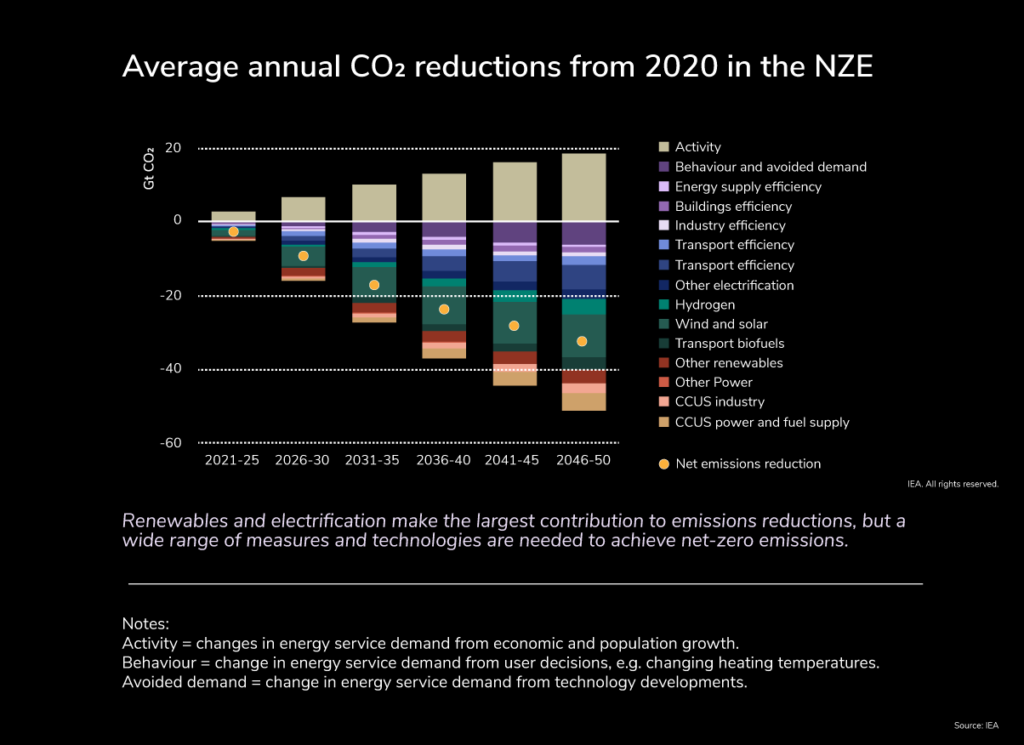
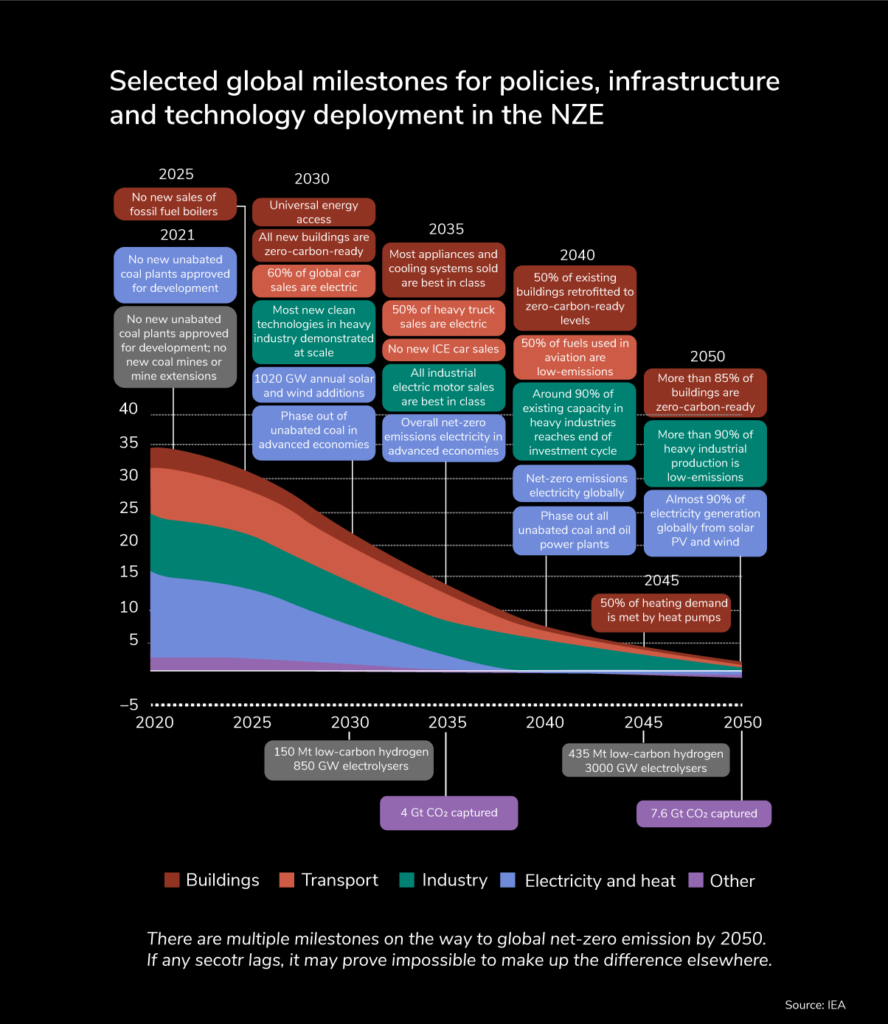
Which scenario to use?
There is almost no research that provides clear-cut instructions with guarantees. In 2021 IEA published a new report titled “Net Zero by 2050: A Roadmap for the Global Energy Sector”. Their goal is to give forecasts with a given level of uncertainty. The uncertainty stems from a reliance on carbon capture technologies that are not yet fully developed, from unknown reinforcing effects that thawing permafrost and shrinking snow cover can have on the warming, and other factors. However, IEA scenarios are more specific and state what technologies, products, and services contribute to the energy transition. We use IPCC and IEA data, predictions, and recommendations to formulate our theory of change, allowing us to integrate this knowledge into action.
Main takeaways
- There is an almost linear relation between climate change and anthropogenic greenhouse gas emissions.
- The most emitted greenhouse gas is CO2. We see record CO2 concentrations in the atmosphere.
- With the current pace of emissions, we will deplete the carbon budget by 2028. The carbon budget is a threshold that cannot pass 1.5-degrees. To avoid severe climatic impacts, we should reduce emissions sooner rather than later.
- The global surface temperature could rise to 1.5°C. Emissions must reach 25 Gt in 2030 to limit the rise of temperature. It is much lower than we emit now (vs 42.11 Gt in 2018, out of which 36.42 are from industry and fossil fuels).
- Scenarios of the Intergovernmental Panel on Climate Change provide a general idea of CO2 concentrations and consequential warming. Their “stringent” pathway, RCP 2.6, predicts warming to be limited to 1.5 degrees. It’s required that CO2 emissions start declining by 2020 and drop to zero by 2100. Higher concentration scenarios predict much more serious climate change impacts.
- International Energy Agency assesses that current policies and commitments are not enough to achieve sustainability, and the momentum behind clean energy technologies is not sufficient. Fossil fuels need to be phased out quickly. Energy efficiency amelioration and electrification need to accelerate.
***
Disclaimer:
The content of any publication on this website is for informational purposes only.



